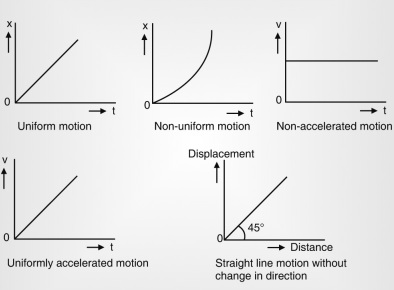Motion
General ScienceA continuous change in the position of the object with respect to time is called motion.
Rectilinear motion: If an object moving in a straight line changes its position with respect to time.
Circular motion: When an object moves at a constant distance from a fixed point, its motion is called circular motion.
Periodic motion: A motion which repeats itself after certain fixed interval of time is called periodic motion.
Oscillatory motion: A motion which is repeated about its mean position periodically is called oscillatory motion. For example, motion of simple pendulum.
Distance: The length of the path fallowed by a body is called distance.
Displacement: The shortest distance between initial and final position of the object is called displacement. It is vector quantity.
Speed: Distance travelled by a body in unit time is called speed.
$$ \text{Speed} = \frac{\text{Distance}}{\text{Time}} $$
$$ \text{Average speed} = \frac{\text{Total distance travelled}}{\text{Total time taken}} $$
Velocity: Displacement of a body in unit time is called velocity.
$$ \text{Velocity} = \frac{\text{Displacement}}{\text{Time}} $$
The unit of velocity in SI system is m/s. Other commonly used unit is km/h. It is a vector quantity.
The SI unit of distance and displacement is metre (m), of speed, velocity, average speed and average velocity is ms-1.
Acceleration: The rate of change of velocity is called acceleration.
$$ \text{Acceleration} = \frac{\text{Final velocity - initial velocity}}{\text{Time}} $$
$$ a = \frac{v - u}{t} $$
The unit of acceleration in SI unit is ms-2. It is a vector quantity.
Equations for uniformly accelerated motion:
$$ v = u + at $$
$$ s = ut + \frac{1}{2}at^2 $$
$$ v^2 = u^2 + 2as $$
where
- u = initial velocity
- v = final velocity
- a = acceleration
- s = distance
- t = time
Distance travelled by a body in nth second:
$$ s = u + \frac{a}{2}(2n - 1) $$
Graphical Representation of Motion
